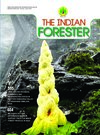Assessing Land-use Land-cover Dynamics (1990-2030) in Pathri Reserve Forest using Geospatial Technology
DOI:
https://doi.org/10.36808/if/2018/v144i7/130922Keywords:
Pathri Reserve Forest, Land Use Land Cover, Geospatial Technology, Markov Modeling.Abstract
Forests being a dynamic feature are prone to changes which may be either positive or negative. The present study has been taken to monitor Land use land cover (LULC) dynamics in Pathri reserve forest over the past three decades (1990, 2000 and 2010), before and after de-reserving some part of this forest in view of the rehabilitation of Tehri dam evacuees. Landsat TM data has been used to generate maps on 1:50000 scale using visual interpretation. The three time period forest vector layers were used for predicting the forest cover for the periods 2010 and 2030 using Cellular Automata (CA) Markov model. The analysis reveals that out of 17.31km2 in 1990, only 2.62 km2 of area was left as dense forest in 2010, while the remaining area was degraded to open forest and scrub. About 13 km2 area of water bodies and wetlands in the study area reduced to 3.4 km2 in two decades indicates demand for intensification of agricultural besides the pressure for fuel wood collection and uncontrolled grazing. This loss of forest over the decades can be attributed to the Rehabilitation Policy, 1998 of the Government of Uttarakhand to resettle the Tehri dam evacuees and relocation of Gujjars, a nomadic community to an 8 km2 patch at Pathri rehabilitation site. Human interventions as well as signs of disturbance such as lopped off trees, presence of invasive species such as Ipomea spp. and Clerodendron spp. could be the causative factors. From the present LULC dynamics and projection for 2030, it is evident that the Pathri reserve forest continues to be under pressure from anthropogenic activities.References
Chakraborty K. (2009). Vegetation change detection in Barak Basin. Current Science, 96(9, 10).
Coppin P., Jonckheere I., Nackaerts K. and Muys B. (2004).Digital change Detection methods in ecosystem monitoring - a review. Inter. J. Remote Sensing, 25 (9): 15651596.
Ekwal I. (2011). Mapping of landscape cover using remote sensing and GIS inChandoli National Park, India. Momona Ethiopian J. Science, 3 (2): 78-92.
Ellis E. and Robert P. (2007). "Land-use and land-cover change." In: Environmental Information Coalition, National Council for Science and the Environment (Encyclopedia of Earth. Eds. Cutler J. Cleveland) (Washington, D.C.: (Retrieved 5th December, 2017). http://www.aughty.org/pdf/landuse_landcover.pdf.
Joshi R. and Singh R. (2009). Gujjar Community Rehabilitation from Rajaji National Park: Moving towards an integrated approach for Asian Elephant (Elephas maximus). Conservation. J. Hum. Ecol., 28(3): 199-206.
Kushwaha S.P.S. (1990). Forest-type mapping and change detection from satellite imagery. J. Photogrammetry and Remote Sensing, 45: 175-181.
Kushwaha S.P.S., Suchismita M., Hari V.P. and Suresh K. (2010).Sustainable development planning in Pathri Rao subwatershed using geospatial techniques Current Science, 98 (11, 10).
Lele N. and Joshi P.K. (2008). Analyzing deforestation rates, spatial forest cover changes and identifying critical areas of forest cover changes in north-east India during 1972-1999. Environmental Monitoring and Assessment, 156 (1-4):159-70.
Lund H. (1983). Change: now you see it- now you don't! Proceedings of the International conference on renewable resources inventories for monitoring changes and trends, Oregon State University, Corvallis, US, 211-213.
Macleod R.D. and Congalton R.G. (1998). A quantitative comparison of change detection algorithm for monitoring eelgrass from remotely sensed data. Photogrammetric Engineering and Remote Sensing, 64 (3): 207-216.
Nandy S., Kushwaha S.P.S. and Dadhwal V.K. (2011).Forest degradation assessment in the upper catchment of the river Tons using remote sensing and GIS. Ecological Indicators, 11(2): 509513.
Reis S. (2008). Analyzing Land Use/Land Cover Changes Using Remote Sensing and GIS in Rize, North-East Turkey. Sensors, 8: 6188-6202.
Roy P.S. and Arijit R. (2010). Land use and land cover change in India: A remote sensing & GIS perspective. J. Indian Institute of Science, 90:4 (journal.library.iisc.ernet.in).
Singh A. (1986). Change detection in the tropical forest environment of North-eastern India using Landsat In: Remote Sensing and Tropical Land Management (New York: John Wiley and Sons), pp. 237–254.
Singh A. (1989). Digital change detection techniques using remotely-sensed data.International Journal of Remote Sensing, 10: 989–1003.
Wani A.A. (2008). Forest cover assessment and trend in central India using remote sensing and GIS.Indian Forester. 134(11): 1529-1538.
Wani A.A., Joshi P.K. and Singh O. (2014). Estimating biomass and carbon mitigation of temperate coniferous forests in the Western Himalayan region using spectral modeling and field inventory data. Ecological Informatics. http://dx.doi.org/10.1016/j.ecoinf.2014.12.003.
Wani A.A., Singh S., Joshi P.K., Zargar M.A. and Wani A.A. (2009). Forest cover mapping and change detection analysis (1960's to 1970's) in some parts of central India using remote sensing and GIS (2009). In: Proceedings of IV National Forestry Conference, Forest Research Institute Dehradun.
Downloads
Downloads
Published
How to Cite
Issue
Section
License
Unless otherwise stated, copyright or similar rights in all materials presented on the site, including graphical images, are owned by Indian Forester.





